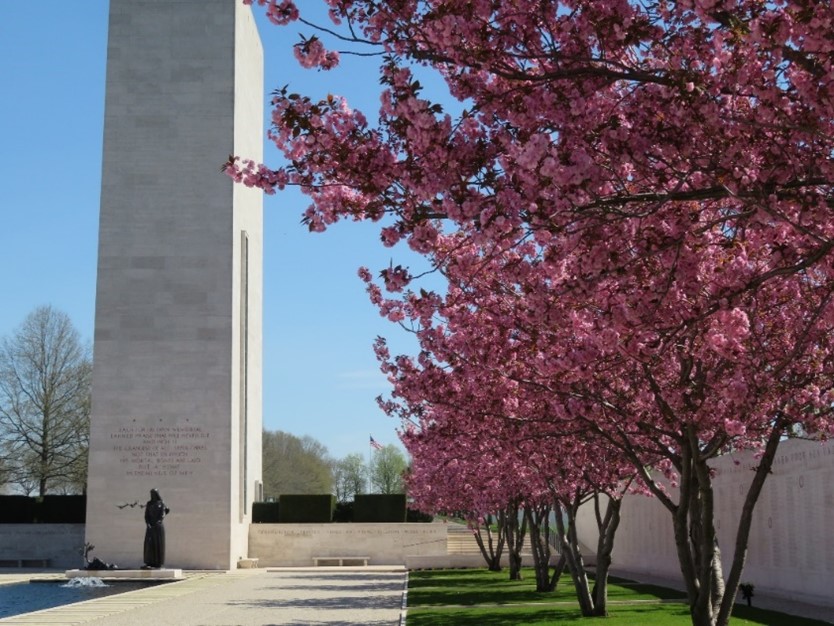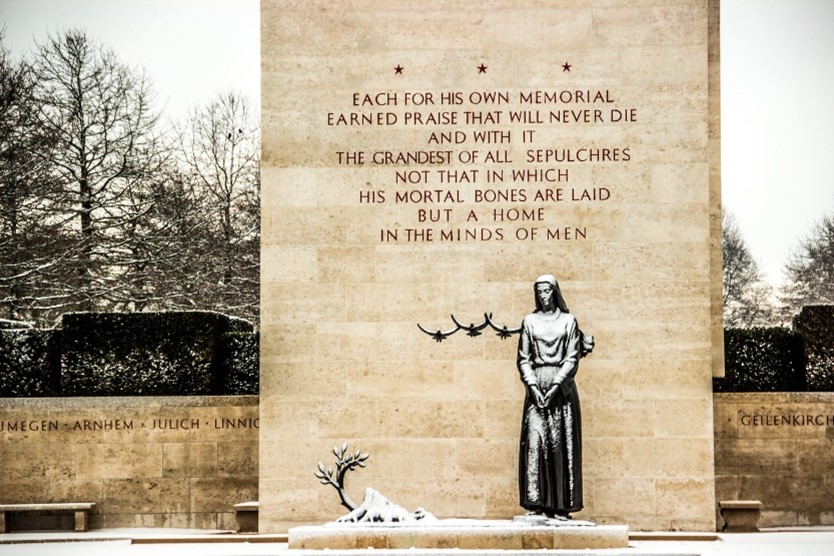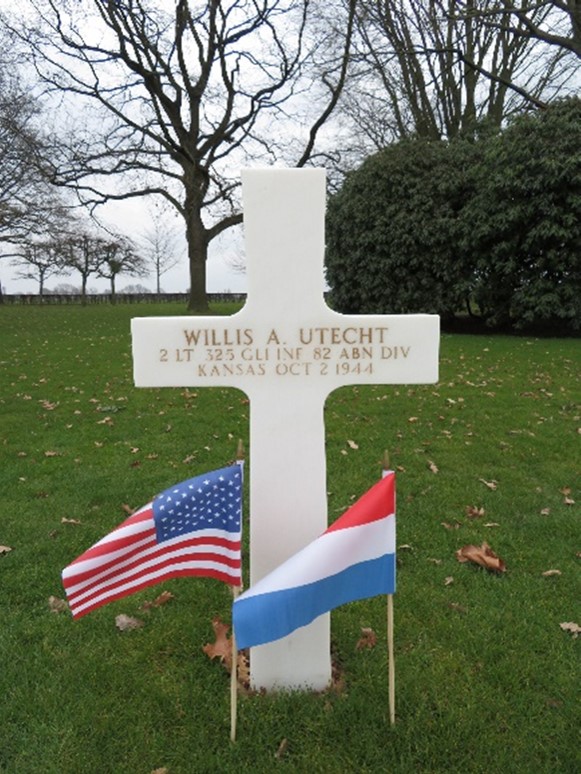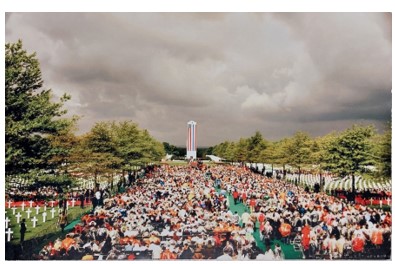The American Battle Monuments Commission’s (ABMC) Netherlands American Cemetery is located in Margraten, the Netherlands. How well do you know this site? Here are five things you may not know about Netherlands American Cemetery.
The only U.S. American cemetery in the Netherlands
South-Limburg, the region of the Netherlands where Netherlands American Cemetery is located, was fully liberated by U.S. Armed Forces. In November 1944, fertile farmland to the west of Margraten became a temporary cemetery for fallen U.S. service members. The cemetery was located near the main road between Maastricht and Aachen, the first German city that the Americans had captured.
Many of the U.S. military buried in Margraten fell during airborne operations in the east of the Netherlands in the fall of 1944 or the advances into Germany in 1945.
In 1947, approximately 18,000 U.S. service members were buried at the temporary cemetery there. Nowadays, approximately 8,300 service members are buried at Netherlands American Cemetery and more than 1,700 are commemorated on its Wall of the Missing. The families had the choice of repatriating their loved ones to the U.S. or bury them in an American Battle Monuments Commission’s cemetery overseas. About 40% chose the second option and had their loved one buried at our sites.

The Statue of the Mourning Woman
The Statue of the Mourning Woman is a unique bronze cast sculpture present at Netherlands American Cemetery. The statue symbolizes the loss that women suffered during the war when their sons, fathers or husbands did not return home.
The statue resembles a woman in mourning, next to a destroyed tree, which symbolizes the destruction of World War II. A new young branch grows from the tree to symbolize renewal and peace after the destruction of war. The message of peace is reinforced by the three doves that fly next to the Mourning Woman.
The statue was designed by the artist Joseph Kiselewski, who considered this sculpture to be his masterpiece. The statue was cast in bronze by the Battaglia foundries in Milan, Italy.

The last burial happened in 1994
2nd Lt. Willis A. Utecht is the last U.S. service member buried at Netherlands American Cemetery after the official opening in 1960. He was 22 years old when he lost his life near the Dutch village of Mook Oct. 2, 1944. Due to battlefield circumstances his body could not be recovered and he was listed as missing in action.
In the 1950s, Utecht’s name was inscribed on the Wall of the Missing at Netherlands American Cemetery. In 1993, a farmer in Mook was ploughing his field and discovered human remains. After an investigation by the U.S. Army Central Identification Laboratory in Hawaii, it was established that the recovered remains belonged to Utecht.
Utecht was buried at Netherlands American Cemetery, on request of his brother Marvin Utecht, Sept. 16, 1994. Marvin Utecht fulfilled the last wish of his younger brother to be buried amongst his comrades-in-arms of the 82nd Airborne Division. A small bronze rosette was placed in front of his name on the Wall of the Missing indicating Utecht is no longer considered missing in action.

One presidential visit.
President George W. Bush is the only American president who visited Netherlands American Cemetery. The visit happened May 8, 2005, for the 60th anniversary of VE Day. Her Majesty Queen Beatrix of the Netherlands was also present at the ceremony. President Bush chose to visit NEAC when he heard about the bond between the cemetery and the local community.
The presidential visit to the cemetery attracted more than 10,000 visitors, who came to honor the legacy of those who fell overseas for their freedom.
The visit was announced only six weeks prior to it and a lot of work had to be done. To ensure the president’s safety many precautions were taken which did not only impact the cemetery but also the entire region of South-Limburg. Frenk Lahaye, who is now the director of the Visitor Center, and local resident, had to show proof of his residency to go home, as his house was located near the hotel President Bush was staying at.

An everlasting local commitment
In the beginning of 1945, the inhabitants of the South-Limburg region wanted to thank and honor the legacy of their liberators, hence the Grave Adoption Program was born.
Local people were able to adopt a grave of a fallen U.S. service member. Adopters visit the graves multiple times a year, bring flowers and look after the grave as if it was their own family. They also try to establish contact with the families of the fallen service members to gather on the story of the servicemen and women they honor.
The program is administrated by the Foundation for Adopting Graves at the American Cemetery Margraten. Currently, all the graves and names on the Wall of the Missing at Netherlands American Cemetery are adopted. Hundreds of people are eagerly waiting on their turn to adopt a grave, which shows the everlasting Dutch commitment to honor the legacy of their American liberators.
Netherlands American Cemetery is the only cemetery in the Netherlands dedicated to honoring fallen Americans who served during World War II. The site was liberated Sept. 13, 1944, by troops of the U.S. 30th Infantry Division, who were advancing northeastward towards the Roer River in Germany, as part of the U.S. First Army. This cemetery, one of the first to be used to bury American service members who fell in Germany, was established here Nov. 10, 1944, by the U.S. Ninth Army. Approximately 8,300 U.S. service members are buried there and more than 1,700 are also commemorated on its wall of the missing.
The ABMC’s mission is to honor the service of the Armed Forces by creating and maintaining memorial sites, offering commemorative services, and facilitating the education of their legacy to future generations. It was founded in 1923 following World War I and its 26 cemeteries and 31 monuments honor the servicemen and women who fought and perished during World War I (WWI), World War II (WWII), the Korean War and the Vietnam War, as well as some who fought during the Mexican American War.
Those sites are a constant reminder of Gen. John J. Pershing’s promise that “time will not dim the glory of their deeds.”
 An official website of the United States government. Here's how you know.
An official website of the United States government. Here's how you know. 